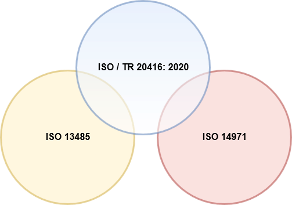

email: info@jutemedical.com | Tel: +44 (0) 7943 055052 | Connect:
ISO TR 20416 2020
Post market surveillance for manufacturers:
An introduction
By Lionel Roberts April 2021
This brief document can be used as primer for ISO / TR 20416:2020.
The potential risks associated with medical devices must be assessed during the initial stages of development.
Once out in the market, risks and product safety data must be both monitored and assessed throughout the products lifecycle.
This continual monitoring and assessing in known as “post market surveillance”.
ISO / TR 20416:2020 seeks to inform us of the necessary requirements and provides examples of methods to help satisfy the post market surveillance requirements for manufacturers.
Note:
ISO / TR 20416: 2020 is designed to work in conjunction with other standards, including ISO 13485 and ISO 14971 and (EU) 2017/745.
So occasionally decisions, actions and information from ISO/ TR 20416: 2020, will overlap with other standards

What is post market surveillance?
Post market surveillance can be broadly described as:
- Monitoring medical device safety and performance
- Data collection
- Data analysis
- Reporting
With the aim of:
- Effectively communicating with regulatory authorities
- Assessing the risk profile of the device
- Contributing to life cycle management and PMCF (Post Market Clinical Follow-up)
- Meeting regulatory requirements
Preparations for Monitoring Medical Device Safety and Performance
A comprehensive quality management system (QMS) for medical device manufacturers will include many processes that require input from the monitoring and performance of medical devices once on the market.
ISO / TR 20416: 2020 is designed to work in conjunction with other standards, including ISO 13485 and ISO 14971 which relate more broadly to the requirements of the QMS for medical device manufacturers. These elements of the QMS must assessed and where appropriate, integrated into the post market surveillance strategy in order to be properly effective.
This will likely include data and details on:
- Faulty device collection
- Analysis that fits into your QMS requirements and that allows you to effectively communicate and comply with regulatory authorities
- Assessing the risk profile of the device
- Contributing to life cycle management
- Meeting regulatory requirements
Data Collection and Analysis
Just as there are a variety of methods to gather data, there are a variety of ways to analyse data, choosing the correct methods of data collection and analysis can be very important to the outcome of your studies.
ISO / TR 20416: 2020 emphasises the necessity of collecting reliable, accurate data, as well as suggesting methods of data analysis that fulfil requirements often required by medical device manufacturers.
To the greatest possible extent, the data should be reliable and in line with the scope and objectives of the broader post market surveillance plan.
Data collection falls into two broad categories:
Proactive and reactive methods are mentioned below (including but not limited to)
Proactive:
- Interviews
- Literature
- PMCF’s post market clinical follow-up studies
- Recall information and regulatory agency information releases.
- Questionnaires and surveys
- Medical device registries
Reactive:
- Complaint reviews
- Incident reports
- Review of non-solicited observations
- Maintenance and service reports
- Regulatory compliance notifications
**Monitoring the market safety and efficacy of devices can be labour intensive, especially when technical and clerical labour must be utilised in so many areas within a company.
But this type of monitoring can provide you with vital knowledge.
Jute medical provides a range of services that can save money, boost productivity and save your organization time! **
ISO / TR 20416: 2020 provides guidance on data analysis, broadly covering the following topics:
Planning of Data Analysis
Emphasises the role of using the correct metrics for the medical device in question, expected demographics of the device users, normal device usage parameters etc. these factors will determine the key aspects of the data analysis requirements.
Methods for Data Analysis
Data analysis will be broadly determined by the general objectives, which will in turn define the post market surveillance data plan, which define the data sources, which will define the data analysis method.
Reporting on Data Analysis
ISO / TR 20416: 2020 provides information on reporting requirements and strategies, briefly summarised the reporting should cover the following topics:
• Report summary
• Background information on the medical device
• Overview and analysis of the data gathered
• Conclusions and recommendations for further action
Examples of Post Market Surveillance Plans
ISO / TR 20416:2020 very helpfully provides post market surveillance plan examples for several different medical devices, each requiring a different approach in strategy, while explaining the rationale of doing so.
Each example is broken down into the following:
• Scope
• Objective
• Responsibilities of the authorities
• Data collection rationale and methods
• Data analysis
• Reporting methods
I hope this document has provided you with an understanding of the details outlined in ISO / TR 20416:2020 and will help you more quickly get to grips with the subject.
